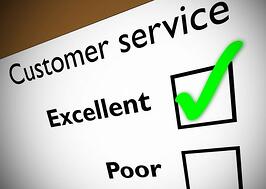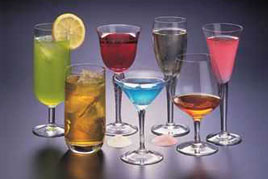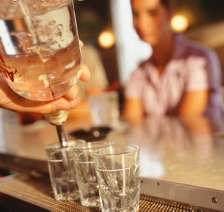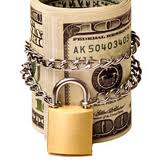By Chris ParryAtlantic Publishing
Getting the Most From Your Patrons
The patron walks in with $20. When the well is dry, he or she will go home (or possibly procure more) but how do you make sure you get as much of that $20 as possible? Consider the following:
- Value-add! It might cost you a buck to make a bourbon and coke and it might cost you two bucks to make a burger. Why not offer your drinkers a cut-price deal on that burger during a certain time of the night: buy two drinks, get a free burger to go with it. You're not making any money on that burger, but you are ensuring that the customer will stay in your bar while they eat it - and probably a little longer. Heck, they might even order a side of deep-fried mushrooms to go along with it.
- Make it easier to stay than go. If your staff is asking people, "Should I get you the bill?" instead of, "How about a round of coffees?" you're only giving your customers an excuse to hit the road.
- Keep the TV interesting. A big error many establishments make is that they leave a TV on but don't pay any attention to what's on it. Keep an eye on your screens and keep an even bigger eye on the TV Guide, to make sure that, if at all possible, you're giving your patrons a reason to stay: "Ooh, ER is on! Maybe I'll have another...
- Read the crowd. On any given night, your entire customer base can change radically. If you look around and find that there are a lot of young people in the place, adapt to suit that audience. Run a one-off special on tequila shots or shooters or turn on the dance-floor lights. Likewise, if a sports crowd comes in unexpectedly, get them into the swing of things by adapting to suit their needs.
- Give valued employees the power to make executive decisions. There's nothing worse, as a customer, than being told, "I don't know, the manager isn't here until later tonight..." Make sure you always have people on staff who can handle a situation and even veer away from the way things normally run, if common sense dictates it. Trust your people to make the right move.
- Cut down on your "no" answers. You might stock Diet Coke, but what about Diet 7-Up? What about veggie burgers? What about fresh-squeezed orange juice? There might not be a whole lot of demand for these products, but if you don't have them when they're asked for, you're giving your customers an excuse not to return, even if they don't make a big deal about it at the time. Don't sink money into something that won't sell, but don't go the other way and reduce what you can sell.
- Merchandise sells! A funky logo doesn't just make your venue more appealing; it sells, too. Research shows that the McDonald's logo is more recognizable to children than the cross symbol of Christianity; so it stands to reason that you could profit nicely from a logo that is "cool" enough for people to wear. T-shirts, golf shirts, baseball caps, key chains, lighters and souvenir glasses - take a tip from the Hard Rock Cafe: if sold well, merchandise can be a bigger earner than alcohol.
This article is an excerpt from the Food Service Professional Guide to Bar & Beverage Operation, authored by Chris Parry, published by Atlantic Publishing Company. This excerpt has been reprinted with permission of the publisher. To purchase this book go to:
Atlantic Publishing Company
Amazon.com
Topics:
Bar staff,
NightClub Management,
bar business,
profit,
Bar Management,
Increasing Profits
By Chris ParryAtlantic Publishing
Upsizing is Essential
When you go to the movies, quite often you can buy a double-sized popcorn for only $0.75 more than the $3.50 regular size. This would seem to be an astonishing bonus for the customer, so why does the cinema operator push this "up-sizing" so hard? Quite simply, because they're selling about $0.04 worth of popcorn for that extra $0.75. That second portion might not bring as large a profit margin as the first, but it's still profit. Your drinks run the same way - if you can get another buck out of a customer selling a drink that costs you $0.45 to prepare, it's worth doing.
-
Consider the cost per ounce of your well spirits. Let's assume you're using El Cheapo brand tequila at a base cost of $7.54 a liter. That would mean that an ounce of that spirit is costing your establishment $0.22, while a more-expensive brand of tequila, let's say Cuervo for the sake of this example, might come at a base cost of $14 per liter, or $0.41 per shot. Common thinking might lead you to say that by using the cheaper tequila you're saving yourself $0.19 on every drink sold. But, if you consider the alternative of up-selling the more expensive spirit for an extra $0.80 or so, you're actually making an extra $0.61 profit on every up-sized drink.
-
Offer your customers a discount to spend more than they planned. This works in other areas, too. Turning a single into a double for an additional dollar, or selling half-price burgers with every shot of a specific brand of spirit, brings you more money per order, while bringing your customers added value. Your profit margin might not be as high, but you'll be extracting more money from your customers than they might otherwise have spent - a definite win-win.
-
Up-selling. Most bar customers will bring out more money than they initially want to spend -just in case - especially those that don't have easy access to it through ATM machines and credit cards, so it's imperative that your staff don't let those customers walk out the door having spent less than they planned. Incentives for up-selling are commonplace in the theater and fast-food industries, so why not offer your staff an incentive to up-sell and watch your better staff earn a few extra dollars while earning you hundreds?
-
Incentives. For example, if a member of your staff engages someone in conversation and discovers they're looking for somewhere to hold a private function, birthday party, girls' night out - any large gathering of people - there's certainly no harm in making it worth their while to bring that prospective client to you. Twenty dollars here, $50 there - even a percentage of the bar take - if you offer the incentives, you'll be surprised how far people will go to bring you new business.
This article is an excerpt from the Food Service Professional Guide to Bar & Beverage Operation, authored by Chris Parry, published by Atlantic Publishing Company. This excerpt has been reprinted with permission of the publisher. To purchase this book go to:
Atlantic Publishing Company
Amazon.com
Topics:
NightClub Management,
bar business,
Bar drinks,
Bar Management,
Liquor cost,
alcohol cost
 By Chris ParryAtlantic Publishing
By Chris ParryAtlantic Publishing
Structuring a Price List
Guesswork just won't do in today's corporate world. Figuring that if your scotch costs you $14 a bottle you can sell a shot for $3, is just a little hit-and-miss when you take in all the other potential costs, like rent, insurance and wages, that your establishment has to cover over the course of a month. It's possible you might be able to charge less than $3, but it's also possible you should be charging way more. Take these factors into account when making your next price list adjustment:
- Market positioning. Take a look around at what your competitors are charging. Figure out if you need to undercut them or match their level. Does your establishment give added value enough to increase your prices and still draw a good crowd? Are you a level above them in terms of services and product? Are you evenly matched? Are you looking for a more "low rent" crowd? Price accordingly.
- The competition. They're not always right, but if they've been around a while, your direct competitors probably have a good gauge of what your local customers are prepared to pay for a drink. Take the time to look around and take particular note of any specials they offer on certain nights.
- Customer demographics. Are your patrons blue-collar workers? Are they white-collar? Do they have families to get home to or are they likely to stay all night and spend every penny? Are they young adults or senior citizens? These all impact what you can charge without losing clientele, and you should have the information already from your market research.
- Embrace simplicity. It's far better for your customers and staff to have to deal with a simple pricing structure as opposed to forcing them to break their brains over an intricate maze of differently priced products. Set across- the-board levels of prices; for example, well spirits might cost $3, middle-shelf $3.50 and top-shelf $4. Of course there's always going to be the occasional variation, but for the most part, a three-tiered system gives you flexibility in pricing without your staff continually needing to check a price list or hand out handfuls of change.
- Include tax in your pricing. There's nothing worse than getting $0.84 change from a five- dollar bill on every drink you buy and getting home with a pocket full of silver and copper. If you're going to set your prices at a round level, include the tax in that price so you can use price levels to your advantage. If your alcohol tax rate is 10 percent, the non-tax price for a shot that costs your patrons $3.50 would be $3.18 ($3.18 plus tax of $0.32 equals $3.49). Let your accountant do the math, not your bar staff. Sales tax is a complicated matter that varies dramatically from state to state. Prior to establishing the net price inclusive of tax, discuss the issue with your accountant and state Department of Revenue. Don't find out later in a five-year audit that you've been calculating the tax incorrectly.
This article is an excerpt from the Food Service Professional Guide to Bar & Beverage Operation, authored by Chris Parry, published by Atlantic Publishing Company. This excerpt has been reprinted with permission of the publisher. To purchase this book go to:
Atlantic Publishing Company
Amazon.com
Topics:
bar business,
Bar drinks,
Bar Management,
Liquor cost,
alcohol cost,
drink recipe
By Chris ParryAtlantic Publishing
Part 2 of 2: Protecting Your Profits
Your profit margin, like that of any business, is fragile at best. You can sit down with a calculator and try to calculate the exact percentage you'd like to see on each drink. But in practice, a little splash too much here and there can see you falling perilously close to a loss. Follow these rules and you'll be that much more likely to see your bottom line behind the bar match that of your balance sheet estimations.
- Watch what your staff pours. Regularly measure what they consider an ounce. If just one bartender overpours 40 shots a night by 25 percent, you've given away ten drinks for nothing. This kind of waste can get very expensive, especially if you have a large bar staff and they're all pouring more than 40 drinks per night.
- Have your staff keep all the liquor in the glass. Many staff members get lazy as the night wears on, and inevitably they'll start taking shortcuts. One shortcut many take is to line up three or four glasses and pour one after the other in a straight line without raising the head of the bottle. While this may save them a second or two, it also pours a lot of your product directly onto the bar surface, not to mention down the sides of the glasses that your customers are about to put in their hands. It also means your customers are far less likely to get what they've paid for. Don't let it happen.
- There are alternatives to free-pouring. While free-pouring certainly is more stylish and perhaps faster than measured pouring, it is also definitely far from accurate. As bar staff generally tend to err on the side of caution, they usually pour too much rather than too little. Control-pour spouts, such as Posi-Pour spouts, are a little more expensive than the usual free-pour, but they give a far more accurate pour without the need for clunky overhead systems or sophisticated electronics - and at much the same speed as free-pourers.
- Liquor control system. If you really want to keep an eye on your outgoings, a liquor inventory control system may be your answer. The price of setting these systems up, and maintaining them, can be significant. Then again, you get what you pay for.
This article is an excerpt from the Food Service Professional Guide to Bar & Beverage Operation, authored by Chris Parry, published by Atlantic Publishing Company. This excerpt has been reprinted with permission of the publisher. To purchase this book go to:
Atlantic Publishing Company
Amazon.com
Topics:
Bar inventory,
managing liquor inventory cost,
bar business,
profit,
Bar Management,
alcohol cost,
bar control,
controling costs
 By Chris ParryAtlantic Publishing
By Chris ParryAtlantic Publishing
Part 1 of 2: The Profits
What does each drink cost you?Without profits, you're out of business, but so many managers see profits as what the owners worry about. Your job is as much to grow profits as to sustain them, so consider putting a little elbow grease into the growth of your establishment by learning about the nickel and dime stuff. A good bar operator needs to wear a number of hats, but the four most important are that of promoter, psychologist, host and accountant. This isn't to say that you need to be of professional standard in all four areas, but you do need a working knowledge of each area, so that you can fine-tune those aspects of your business. On the accounting side of things, you need to be able to assess what every piece of your business costs. Also, as your spirits and liqueurs are a very large segment of your inventory, you should learn exactly how much each and every drink you sell actually costs you. Follow these exercises and you'll be able to assess exactly which drinks bring you the highest profit margin and which drinks could use a price increase.
- Cost per ounce. There is 33.8 ounces in a liter, so if you're paying $15 a liter for a certain spirit, simply dividing that amount by 33.8 will bring you the beverage's ounce cost (in this case, $0.44). If your bottle size is 750ml, then divide the bottle cost by 25.35 to get the ounce cost. Likewise, dividing a 500ml bottle by 16.9 will give you that product's ounce cost.
- Total beverage cost. When calculating what it costs you to provide a mixed drink to a customer, simply figure out the ounce cost of each item in the drink. A half-shot means adding half the ounce cost of that shot, whereas a double shot would mean doubling the ounce cost. Make sure to include every aspect of the drink, such as mixers, dashes of cordial and garnishes. The total of each of these ounce costs will be your "beverage cost" for that drink.
- Cost percentage. When you're investing in inventory, you want to know that you're getting a good return on your money and the best way to figure out your percentage return is to estimate your cost percentage for each drink you sell. Simply divide your ounce cost (or bottle cost) by the sale price you've set for that item and then multiply that number by 100. The total will tell you exactly what percentage of the final drink price you are spending on the purchase of its raw contents. The lower the number, the more profit you're making.
- Gross profit margin. To figure out each item's gross profit, simply deduct the cost price from the sale price. To figure out your gross profit margin, take the gross profit, divide it by the sales price and multiply it by 100. The figure remaining is your gross profit margin. You may well find it varies greatly from beverage to beverage. This will tell you which items have a high enough profit margin to push on your customers and which items are just making up the numbers.
This article is an excerpt from the Food Service Professional Guide to Bar & Beverage Operation, authored by Chris Parry, published by Atlantic Publishing Company. This excerpt has been reprinted with permission of the publisher. To purchase this book go to:
Atlantic Publishing Company
Amazon.com
Topics:
bar business,
alcohol cost,
Increasing Profits,
Reducing Costs,
Reducing Liquor Costs,
inventory control
BAR MANAGEMENT
by Bob Johnson
Over pouring, free drinks for buddies, grabbing an extra few beers or R e d Bulls—Is bartender theft inevitable? No, says bar management expert Bob Johnson. Here, Johnson offers six ways to ensure that you’ll hire an honest barkeep.
My first book about bartender theft, written five years ago, was called “The 45 Ways Bartenders Can Rob You Blind.” Now it’s up to 51! Just when you think you’ve uncovered all the ways bartenders steal, they come up with new ways. A bartender was caught recently at a casino inAtlantic Citywith a hypodermic needle injected into an overhead liquor line from an electronic inventory control system, sucking out the liquor into a six ounce vial which he was going to take out to his bartender buddy at the pool bar. He was found with three vials in his pocket already. This is an advanced method of “bringing in your own liquor” (theft technique #14 in my book). Not all bartenders are thieves, but I’ve caught so many bartenders stealing, I’m beginning to wonder. I am told there is no solution; that, in essence, you’re always going to have bartender theft. But I disagree. I believe you can keep the theft to an absolute minimum if you simply hire right. Get the right people on board to begin with and you will have fewer problems with theft. But it’s a full time job keeping your people honest.
The majority of employee theft is created by owners and managers who know little to nothing about running a bar. There’s probably no inventory control system in place. No controls means bartenders now have the “opportunity” to steal unabated. If bartenders are never held accountable for their performance behind the bar and what they do with each and every drink, and how it is accounted for, then they’re free to do whatever they want whenever they want. Inventory control should be a daily regimen. It’s the biggest and most important part of a bar manager’s job. Therefore, if there is no daily accounting, bartenders have nothing to fear. They can give away beers/ drinks, take the money for a drink and put it in their pocket, etc., because there’s no way for anyone to know for sure what’s going on.I’m going to share my ways of controlling bartender theft. It’s taken me three or four decades to put all this together. The methods I use work well for me and it works for the clubs I’m operationally involved with. It will never be 100 percent, but I’m pretty close to it! Controlling bartender theft starts with the hiring process.
Topics:
bar theft,
bartenders you can trust
BAR MANAGEMENT
by Bob Johnson
In an adult nightclub, cocktail servers are required to do much more than simply take orders and hand out drinks. According to bar management ex pert Bob Johnson, there are several nuances that, if employed correctly, can turn a good cocktail server into a great one.
In part two of this two-part series, Johnson provides servers with detailed information on how to properly handle house and serving policies, while offering dentitions on some common drink ordering phrases.
Part 1:
How important are servers?
The server is the main person that interacts with the customer during their visit to your club. Being a good server is perhaps the most difficult job in the bar business. It requires many skills, a mature attitude and a great personality. You should reconsider the ago old adult entertainment theory of turning a cocktail server into a dancer. A cocktail server who can easily converse with customers, gives great service, remembers names, remembers drinks and shows personality is more effective on the poor than being a dancer on stage. Plus, they are more accessible than a dancer. The following article provides detailed information for cocktail servers on how to properly administer house and serving policies, and includes dentitions on some common drink ordering phrase s. Being a good cocktail server means more than just taking orders and bringing drinks; hope fully, this article will help de ne their roles in a successful adult nightclub.
Topics:
Bar staff,
Bar trends,
NightClub Management,
Nightclub Consulting,
Drink Recipes
By Chris ParryAtlantic Publishing
Part 2: Do Bartenders Create Regulars?
 A bar business is not, as many people think, a service industry. Of course, it's part service industry, but it's also very important not to forget that it's also an entertainment industry. Do your bartenders entertain your customers while they are serving them?
A bar business is not, as many people think, a service industry. Of course, it's part service industry, but it's also very important not to forget that it's also an entertainment industry. Do your bartenders entertain your customers while they are serving them?
- Every customer is an asset to your business. Just as you wouldn't throw chairs and tables away after one use, so too should you do everything in your power to make sure that every customer comes back again and again. Your staff must know that this is your goal. They must realize that they're the front-line weapons in the battle for customer retention.
- Customer needs. Every staff member, from host to bartender to manager, should be able to handle any customer's needs. If a hostess walks past a table that obviously needs clearing without lifting a finger, how do you think that will leave those customers feeling about the service standard in your bar?
- People seated at the bar. They should be treated like old friends by your bar staff, at least when they first sit down. But just as it's important to engage customers in conversation when they're happy to talk, it's also important to leave them alone when they don't. A good bartender reads the client's mood.
- Flair bartending is all the rage. Bartenders who consider their job to be more than a temporary source of income see themselves as the next Tom Cruise in the movie Cocktail. While putting on a show for the customers is a great way to entertain them, putting on a bad show is not. If your staff want to sling bottles and glasses around the bar in style, make sure they work within their limitations and save the practicing for after-hours.
- Staff incentives. Some bar operators give incentives to their bar staff to stay around after their shifts and get to know the customers. Discounted drinks and food are not only a relatively cost-effective way to have your staff spend their free time at work, but these methods also help convince them to bring their own friends and turn your bar into their regular watering hole.
This article is an excerpt from the Food Service Professional Guide to Bar & Beverage Operation, authored by Chris Parry, published by Atlantic Publishing Company. This excerpt has been reprinted with permission of the publisher. To purchase this book go to:
Atlantic Publishing Company
Amazon.com
Topics:
Bar staff,
alcohol,
Bar trends,
NightClub Management,
Bar Management,
Nightclub trends,
opening a bar,
hospitality jobs,
liquor
By Chris ParryAtlantic Publishing
Part 1: Recruiting a Security Staff
 Knowing when and how to recruit security staff is an important part of any popular bar operation. Should you hire your own or deal with a security firm? If you hire your own people, what rules do you set for them? How do you avoid getting sued if someone is removed forcibly? Many venues utilize outside security firms to provide security on busy nights, and most do so as a means of simplifying their security needs and reducing liability issues. But an outside contractor doesn't always make things easier:
Knowing when and how to recruit security staff is an important part of any popular bar operation. Should you hire your own or deal with a security firm? If you hire your own people, what rules do you set for them? How do you avoid getting sued if someone is removed forcibly? Many venues utilize outside security firms to provide security on busy nights, and most do so as a means of simplifying their security needs and reducing liability issues. But an outside contractor doesn't always make things easier:
- Outside contractors. This means you don't need to concern yourself with compensation, holidays, sick days, wages, etc. However, it also means that your level of control over the standard and selection of those who work at your venue is reduced. Also, with security firms costing more per hour than individual contractors or staff, your bottom line can suffer. Consider hiring one or two of your own staff who you can use on regularly busy nights and filling in any gaps with contractors that may come up.
- In-house employees. While harder to find, train, and do background checks on, they are usually more loyal and tend to stay longer than contractors. If you want to have complete control over how your security behaves, how they deal with customers and their loyalty to the company, there can be no better way to work than to simply employ the best people you can find.
- Security personnel. Hiring security and calling them independent contractors to avoid liability and payroll taxes is a tactic some bar operators employ to make the process simpler and cheaper. But this can bring more problems than it solves. If your security "contractor" does injure someone when removing him or her from the premises, are you confident that your "contractor" won't claim she is an employee? Do you need that kind of a fight?
- Rules. Security guards need ironclad rules of engagement that dictate what they can and cannot do. Ensure that rules are in place that every security employee knows and signs. So, if there is a liability problem down the road, you can point out that your rules were broken and that you were not in any way negligent in your duty of care to the client.
- ALWAYS do a background check on your potential security staff. It may cost a little and extend the hiring process, but if you don't want a 300-pound cocaine addict to be throwing your customers around a back alley, you'll want to make sure you're not hiring any 300-pound cocaine addicts.
- Attorney involvement. Talk to your lawyer about drawing up any and all papers you'll need to ensure that your organization is completely covered and doing everything it can to ensure your security staff behave responsibly. Spending a hundred bucks today on legal fees can save you thousands down the road. Similarly, check with your insurance company to confirm your legal liability responsibilities to your security staff.
- Subcontracting security staff is a legitimate means of filling a need. This works if you really don't have the time to micromanage your security concerns, or to fill in during times when your regular staff is unavailable or inadequate in number. You can subcontract individuals as long as you give them a Form 1099 for any cash paid over the $600 mark; this will, in turn, keep your workers' compensation bill down.
- Equip your security staff for their job. Spotting fake IDs isn't always easy. If you have 200 people waiting to go through your door, your security staff can't spend five minutes with every person, but there are tools available that can help. An electronic ID-checking unit will read the magnetic strip on any state driver license, verify that the license is valid, and display the holder's exact age - not to mention point out if the document is a fake or has been tampered with. These systems are small, inexpensive to purchase and limit the chance that your staff will let in an underage drinker. Talk to Intelli-Check (www.intellicheck.com) by calling 800 444-9542.
This article is an excerpt from the Food Service Professional Guide to Bar & Beverage Operation, authored by Chris Parry, published by Atlantic Publishing Company. This excerpt has been reprinted with permission of the publisher. To purchase this book go to:
Atlantic Publishing Company
Amazon.com
Topics:
Bar inventory,
NightClub Management,
bar business,
Bar Management,
Nightclub Consulting,
opening a bar,
bar control,
Control,
inventory control
By Chris ParryAtlantic Publishing
Part 3: Theft-Reduction Procedures
 More often than not, scams and thievery can be detected and/or prevented relatively easily. Strict enforcement of all employee rules is a must and vigorous prosecution of any offenders is essential. Employees must be made clearly aware of the dire consequences of flouting the house rules - every detail must be addressed.
More often than not, scams and thievery can be detected and/or prevented relatively easily. Strict enforcement of all employee rules is a must and vigorous prosecution of any offenders is essential. Employees must be made clearly aware of the dire consequences of flouting the house rules - every detail must be addressed.
- Have a manager total the cash at the end of a bar shift. While the bartenders may feel distrusted, you can always point out that the rule is in place to protect honest staff.
- House rules. All new members of staff should be required to sign a confirmation that they have read the house rules, fully understand the implications involved and agree to follow the rules to the letter.
- No drinking on duty. Prohibit all bartenders from drinking while on duty. Also, strictly regulate off-duty drinking. Off-duty drinking can see fellow bar staff overpouring, giving away free drinks or undercharging their colleagues, and while staff should be encouraged to socialize with patrons after hours, this should be closely watched.
- Bartenders should not be involved in the
stock-taking and inventory-counting process. Nor should they be involved in receiving, ordering or issuing inventory. It might be a painful process, but this really should be a management-only function.
- High-value inventory. Strictly enforce all security procedures for liquor, wine, beer, spirits and any other high-value inventory. Only key personnel should have access to storage areas, and everything that comes out should be duly noted.
- Require bartenders to record post-shift bar-
par readings. This refers to the number of bottles left in fridges and behind the bar after a shift has ended. Engage in spot-checking of this count to ensure that no thieving is taking place.
- Prohibit the practice of recording more than one transaction per drink ticket. If your bartenders are allowed to use a "running" ticket, they can easily neglect to record all the drinks they have actually sold and pocket the difference.
- Strictly enforce voiding procedures. If an amount is rung up on the register, the bartender should not be allowed to void it without management approval.
This article is an excerpt from the Food Service Professional Guide to Bar & Beverage Operation, authored by Chris Parry, published by Atlantic Publishing Company. This excerpt has been reprinted with permission of the publisher. To purchase this book go to:
Atlantic Publishing Company
Amazon.com
Topics:
liquor inventory,
Bar inventory,
bar inventory levels,
Bar staff,
liquor theft,
Bar Management,
bar control,
inventory counting,
inventory control



 By Chris Parry
By Chris Parry
 By Chris Parry
By Chris Parry

 A bar business is not, as many people think, a service industry. Of course, it's part service industry, but it's also very important not to forget that it's also an entertainment industry. Do your bartenders entertain your customers while they are serving them?
A bar business is not, as many people think, a service industry. Of course, it's part service industry, but it's also very important not to forget that it's also an entertainment industry. Do your bartenders entertain your customers while they are serving them?
 More often than not, scams and thievery can be detected and/or prevented relatively easily. Strict enforcement of all employee rules is a must and vigorous prosecution of any offenders is essential. Employees must be made clearly aware of the dire consequences of flouting the house rules - every detail must be addressed.
More often than not, scams and thievery can be detected and/or prevented relatively easily. Strict enforcement of all employee rules is a must and vigorous prosecution of any offenders is essential. Employees must be made clearly aware of the dire consequences of flouting the house rules - every detail must be addressed.
